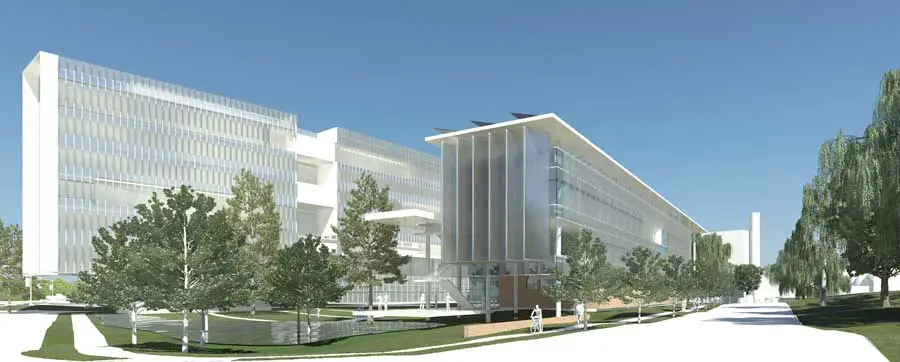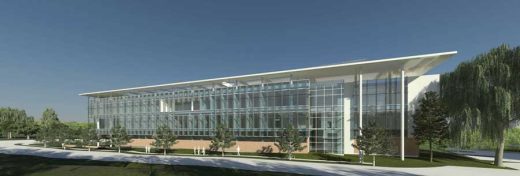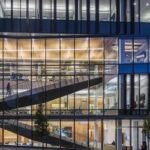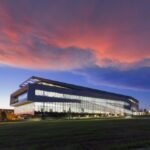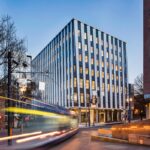University of Florida Building, FL Clinical Translational Research facility aAchitects, United States of America news
University of Florida Clinical Translational Research Building
IOA-CTRB Development design by Perkins+Will Architects, USA
Aug 9, 2010
Location: Gainesville, north Florida, United States of America
Architect: Perkins+Will
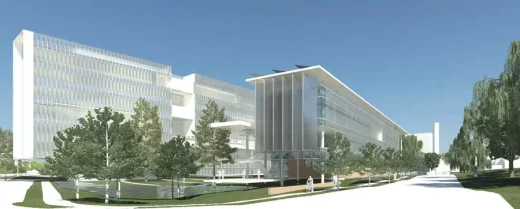
image from Perkins+Will architects
University of Florida Clinical Translational Research Building for the Institute on Aging
Sustaining life itself provides healing. This is the center pillar of the design philosophy behind the new project for the Institute on Aging of the University of Florida (IOA-CTRB). A building that promotes healing and responds to the emergent site, cultural and environmental forces, in perfect alignment with the University’s commitment to make its campus a sustainable and attractive place to learn, work and live.
Functional Organization
The CTRB is situated on a 2.57 acre site along Mowry Road and Gale Lemerand Drive in the city of Gainesville, Florida, USA. The building is sited to capitalize on the proximity to the Health Science Center of the University of Florida. The overall master plan for the project has been planned as two wings with a connecting hub on the east side.
This central organizing element contains a two story glass-walled atrium-lobby with an open-air communicating stair, two multi-purpose rooms, and building service areas. This central building hub is placed north-south to connect the 39,500 GSF Phase One building with future phases and allow for convenient pedestrian circulation from the parking structure. Drop-off zones are planned for both sides of the building lobby to serve Phase One and Two.
The Phase One design establishes a direction for all clinical research spaces to be located on the ground floor for easy access for the study participants. Administrative, office, and support spaces for staff and researchers are accommodated on the second and third floors.
All floors are connected by a series of cascading stairs which facilitate direct circulation, communication and collaboration among the researchers from the various disciplines. The design establishes outdoor gathering places that are extensions of those within the interior space.
Exterior
The CTRB building is composed as two wings that are oriented to maximize exterior glazing exposure toward the North and South, whose solar heat gain is substantially easier to control. The North wing is planned for future phase growth, while the South wing is dedicated to the Institute on Aging in Phase One.
The overall architectural design and orientation has helped to dramatically reduce heat gain through the exterior walls, while allowing the design to take advantage of ample daylight available in Gainesville.
The building massing is an expression of the internal program while minimizing the environmental impacts. Each building facade and level responds to the facing orientation, exposure and program. From the roofs harvesting solar energy and collecting rainwater to the glazed curtain walls providing views and natural daylighting, each building material and element has a function in serving the building’s high performance goals.
Interior
Interior design is focused on human scale and healthy environments. All occupied spaces will receive daylight with limited direct solar heat gain. The building design as a whole employs glazed longitudinal (East-West) walls to allow for North and South views to interior corridors and spaces.
Showcasing research activities and encouraging teamwork across disciplines are both made possible through the space layouts. The design includes wide corridors and collaboration zones off the public areas for informal interactions and chance encounters between researchers and staff.
Way-finding and accessibility issues will be critical for theses elderly friendly and barrier free environments. As this building will be inviting researchers, study participants and community outreach programs to this campus, entrance points are located to facilitate easy entry and exiting from the building and campus.
The access points are located in a common public space: a 2-story atrium with balconies, a monumental stair, and elevator lobbies. The Phase One-Institute on Aging reception area will be immediately visible upon entry and at the opposite end of the atrium will be the Phase Two reception area.
The building will serve as an example and a catalyst for future green buildings at the University of Florida.
Sustainability
Considering Nature as both model and context, the building is designed to harness the available natural forces. Its roof harvests solar energy to produce hot water and generate electricity and collects rainwater that flows to a cistern to be later use to flush toilets and urinals.
Its envelope reacts to the force of the sun with vertical fins or projecting canopies. Using BIM (Building Information Modeling) tools such as Revit, Ecotect and Radiance, the design intent is to strike a balance between daylight use and solar heat gains. In this process, the proportions of the floorplates are studied as a response to the physical properties of light transmission. From the perimeter towards the center the building stops growing where daylight falls below acceptable limits.
The building seeks to minimize its environmental footprint not only through indirect measures, such as using only materials that are not harmful to any species, or by offsetting the embodied carbon footprint of the building materials, but also through direct measures such as reducing its physical footprint and partially replacing the site developed area with vegetated walls and roofs. In this way the site grows back through the walls into a roof that becomes a green terrace (upon roof over Lobby/Multi-purpose rooms, below), which in turn connects to outdoor collaborative spaces.
Borrowing ideas from the theory of Biophilic design, the site seeks to manifest in its structure the inherent human affinity to affiliate with natural systems and processes. It does that by its embodiment of a naturalistic dimension that reveals itself in the form of a leaf. As the leaf is drawn in the canvas of the site it begins to work as leaf structures are intended to do, by carrying storm water through vein-like channels into a central creek/mid rib that finally discharge its content into a retention pond.
UF has mandated that the project will be aggressively pursuing a LEED Platinum certification with the US Green Building Council, incorporating Sustainable Design concepts that will take into consideration Carbon Neutral goals and Living Building Challenge criteria.
University of Florida Clinical Translational Research images / information from Perkins+Will
University of Florida Clinical Translational Research architects : Perkins+Will
Location: Gainesville, Florida, USA
Florida Architecture
Florida Southern College Building
Frank Lloyd Wright Architect
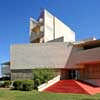
photo © Robin Hill
Florida Southern College
Another Florida University Building:
University South Florida Polytechnic
Salvador Dali Museum, St. Petersburg
HOK Architects
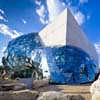
image : Moris Moreno
Salvador Dali Museum
American University Buildings
University California San Diego
University Medical Center Princeton Hospital
Washington University St Louis
Website: University of Florida
Wisconsin Institutes Medical Research
Comments / photos for the University of Florida Clinical Translational Research Building design by Perkins+Will Architects in FL, USA, page welcome.

